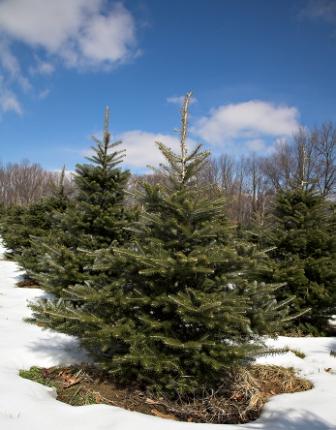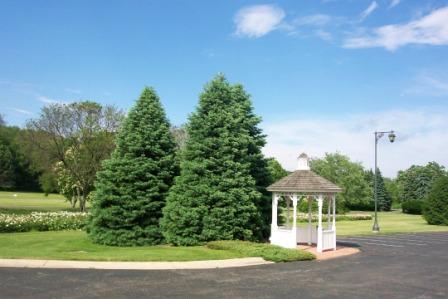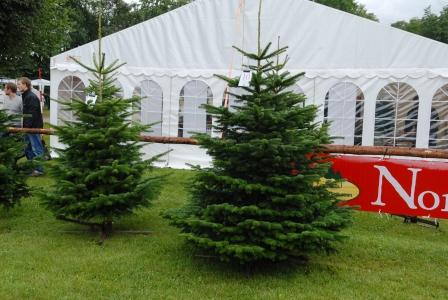OK, it’s the middle of December so I get to indulge my passion for Christmas trees. One of the most interesting projects I’ve gotten to work on during my time at Michigan State is a study to look at alternative species of firs (Abies spp) for Christmas trees and well as for landscape conifers. Firs are fascinating trees that are distributed throughout temperate regions of the northern hemisphere. There are about 50 species, many of which are important for timber, landscaping or Christmas trees.
For those of you that put off your Christmas tree shopping until the end (or want to start thinking about next year’s tree) here are three trees to keep an eye out for.

Korean fir Abies koreana We have several growers in Michigan that are now growing Korean fir. It has relatively short needles that have a bottle-brush arrangement on the stem. The color is often described as dark green, but I’d say the needles tend more to a true green or Kelly green with a silvery underside.

Concolor fir also makes a great landscape conifer
Conolor fir Abies concolor I grew up in the Northwest so I always knew this tree as white fir until I moved to the Midwest. In any case, it’s a great tree. Long, soft-blue needles. Depending on the seed source they can be as blue as a blue spruce. The main draw-back here in Michigan is that concolor tend to break bud early, which makes them susceptible to frost damage in the spring. Their citrus-like scent is hard to beat.

Danish growers compete for the best Nordmann fir in the “Fight for the Golden star” at their annual tree fair.
Nordmann fir Abies nordmanniana Denmark is the leading producer of Christmas trees in Europe and Nordmann fir is their principle species. The Danes like Nordmann because of its deep, dark green color and natural form and symmetry. Europeans don’t like their Christmas trees sheared so they rely heavily on genetics and selection to find trees that naturally have good form. We’re starting to see more Nordmann in the US, both here in the Midwest and in the Northwest. Growers complain that the trees are slow-growing to start but I think some US consumers are looking for a more open, natural-looking tree and Nordmann can fill this niche.
Nordmann Firs are excellent trees but IMO it’s somewhat sad that here in Austria they have largely replaced all other species to be used as Christmas trees. Shopping for a Christmas tree in Vienna you’ll find 99.9% of the trees are Abies nordmanniana and it’s nearly impossible to find a native Silver fir (Abies alba) for example.
Johannes,
Thank you for your comment. Nordmann fir is a great tree but it’s a shame your growers aren’t planting more species. In Michigan our growers currently grow 20% Pinus sylvestris, 20% Pseudotsuga, 20% Abies fraseri, 20% Picea pungens, and 20% several other species. Many of our growers enjoy trying new species. By the way, our International Christmas Tree Research and Extension meeting will be in Sankt Pölten-Land this summer. Maybe we can convice your growers to diversify!
Here in central VA, it’s pretty much all Fraser Fir. I’ve always tried to give customers options by offering Concolor, Douglas, White Pine, and even Leyland Cypress. Sadly, a little over 10 years ago, the market seemed more diverse in regards to variety of trees. We would sell grand fir, noble fir, nordmann fir, Scotch pine, Engelmann spruce, and so on. Once freight became an issue, marku
ps on the trees became greater and you’d start to sit on the trees eventually selling them really cheap right before Christmas.
The challenge for growers is trying to anticipate what the market is going to be in 7-8 years. We saw a lot of acres go into Fraser in the late 90’s, early 2000’s, especially in NC but elsewhere as well, so that’s what’s out there now. I think the wholesale market will tend to be dominated by a few speceis but we have several choose and cut operators that have what I call ‘Christmas tree boutiques’ where they offer a variety of species, in some cases the species are even inter-planted so customer can wander down a row and look at 6 or 8 types of trees before they cut.
We’re really enjoying the Abies lasiocarpa var. arizonica we picked up this year. Seems to have nice needle retention, in addition to attractive cream-colored bark and a slightly blue-ish tone to the needles.
Sorry, I can’t seem to find a way to contact you via e-mail, but I’m a frequent reader of The Garden Professors, and I was wondering if you might write about one of these topics sometime: http://www.alternet.org/story/149150/leaked_memo_sheds_light_on_mysterious_bee_die-offs_and_who%27s_to_blame/?page=entire or http://www.gardenrant.com/my_weblog/2010/12/jeff-ball-comes-to-the-defense-of-peat-moss.html Thanks, and Merry Christmas!
We’re really enjoying the Abies lasiocarpa var. arizonica we picked up this year. Seems to have nice needle retention, in addition to attractive cream-colored bark and a slightly blue-ish tone to the needles.
We always get the Silver tip fir – Abies magnifica – as it is native here in CA. Until he decided he was too old to be traipsing the mountains in the snow, he’d get one straight from the National Forest (yes, he had a permit). It took us a long time to find any tree farm that grew them, but one has now earned our loyalty & Christmas dollars by not shearing theirs. We prefer the natural open-branch look of this species to the artificial “fluffy” look.
Interesting post and interesting comments as well! Shearing of Christmas trees around here is absolutely unheard-of.
Bert, yes please, do promote growing different species at the conference.
Johannes,
We hosted soem Danes and otehr Europeans a few years ago for our Christmas tree conference. They kept making fun of our ‘Donald Duck’ Christmas trees! They said the trees looked like something from a cartoon!
Michele:
I have forwarded your request on to the rest of the group. I think Linda has posted on the peat moss issue before and Jeff is probably the most qualified to talk about the bee issue.
Thank you Bert!
I like a noble fir myself, but i wish unsheared trees were more available. I hate sheared trees.
I like the idea of Korean Fir, as I have been toying with the idea of planting seed from’Silberlocke’ for some futre xmas trees for myself.
I’ll defend sheared trees, I like them! I much prefer balsam over fraser fir though. I love Concolor, noble, and silver firs but all are fairly expensive as xmas trees. Nordmans are a nice tree as well, I hope we see more in the future here.